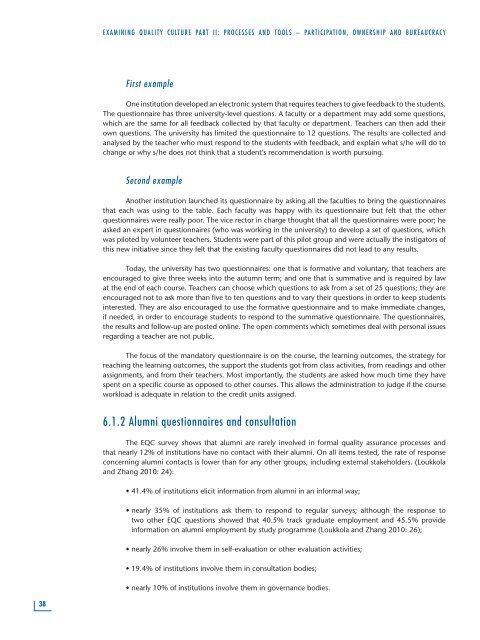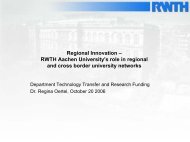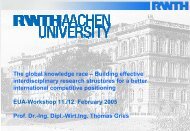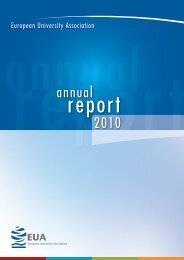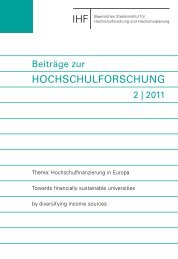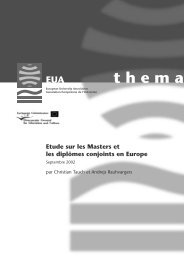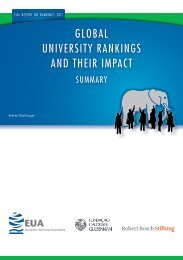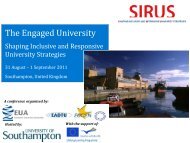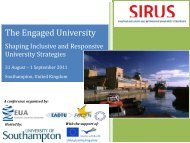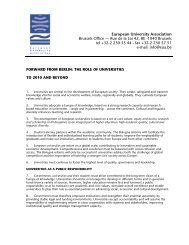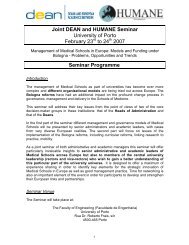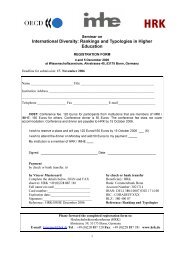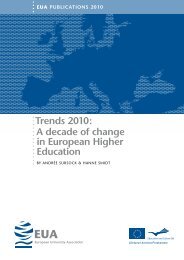Examining Quality Culture Part II: - European University Association
Examining Quality Culture Part II: - European University Association
Examining Quality Culture Part II: - European University Association
You also want an ePaper? Increase the reach of your titles
YUMPU automatically turns print PDFs into web optimized ePapers that Google loves.
38<br />
ExAmININg QUALITy CULTUrE PArT <strong>II</strong>: PrOCESSES ANd TOOLS – PArTICIPATION, OwNErShIP ANd BUrEAUCrACy<br />
First example<br />
One institution developed an electronic system that requires teachers to give feedback to the students.<br />
The questionnaire has three university-level questions. A faculty or a department may add some questions,<br />
which are the same for all feedback collected by that faculty or department. Teachers can then add their<br />
own questions. The university has limited the questionnaire to 12 questions. The results are collected and<br />
analysed by the teacher who must respond to the students with feedback, and explain what s/he will do to<br />
change or why s/he does not think that a student’s recommendation is worth pursuing.<br />
Second example<br />
Another institution launched its questionnaire by asking all the faculties to bring the questionnaires<br />
that each was using to the table. Each faculty was happy with its questionnaire but felt that the other<br />
questionnaires were really poor. The vice rector in charge thought that all the questionnaires were poor; he<br />
asked an expert in questionnaires (who was working in the university) to develop a set of questions, which<br />
was piloted by volunteer teachers. Students were part of this pilot group and were actually the instigators of<br />
this new initiative since they felt that the existing faculty questionnaires did not lead to any results.<br />
Today, the university has two questionnaires: one that is formative and voluntary, that teachers are<br />
encouraged to give three weeks into the autumn term; and one that is summative and is required by law<br />
at the end of each course. Teachers can choose which questions to ask from a set of 25 questions; they are<br />
encouraged not to ask more than five to ten questions and to vary their questions in order to keep students<br />
interested. They are also encouraged to use the formative questionnaire and to make immediate changes,<br />
if needed, in order to encourage students to respond to the summative questionnaire. The questionnaires,<br />
the results and follow-up are posted online. The open comments which sometimes deal with personal issues<br />
regarding a teacher are not public.<br />
The focus of the mandatory questionnaire is on the course, the learning outcomes, the strategy for<br />
reaching the learning outcomes, the support the students got from class activities, from readings and other<br />
assignments, and from their teachers. Most importantly, the students are asked how much time they have<br />
spent on a specific course as opposed to other courses. This allows the administration to judge if the course<br />
workload is adequate in relation to the credit units assigned.<br />
6.1.2 Alumni questionnaires and consultation<br />
The EQC survey shows that alumni are rarely involved in formal quality assurance processes and<br />
that nearly 12% of institutions have no contact with their alumni. On all items tested, the rate of response<br />
concerning alumni contacts is lower than for any other groups, including external stakeholders. (Loukkola<br />
and Zhang 2010: 24):<br />
• 41.4% of institutions elicit information from alumni in an informal way;<br />
• nearly 35% of institutions ask them to respond to regular surveys; although the response to<br />
two other EQC questions showed that 40.5% track graduate employment and 45.5% provide<br />
information on alumni employment by study programme (Loukkola and Zhang 2010: 26);<br />
• nearly 26% involve them in self-evaluation or other evaluation activities;<br />
• 19.4% of institutions involve them in consultation bodies;<br />
• nearly 10% of institutions involve them in governance bodies.


